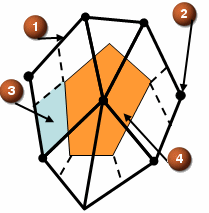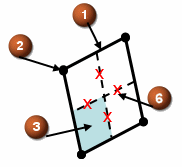Control-volume method
The flow solver uses a finite-element based control-volume method for discretization of the governing equations. With this method, the governing equations are integrated over a control volume and over a time step.
For example, the finite-element based control-volume method [5] for the integration for the conservation equation of the passive component is:
- V is the control volume.
- δt is the time step.
Using Gauss's theorem to convert a volume integral to a surface integral, it becomes:
- nj is the unit outward surface normal of the control volume surface.
- A is the outer surface area of the control volume.
The flow solver approximates numerically the volume and surface integrations over a discrete finite volume defined on a computational grid or mesh. For instance, the advection term is approximated as:
where the discrete mass flow through a finite sub-surface of the finite volume is defined as follows:
In these equations:
- ip denotes the integration point of the sub-surface.
- ΔA is the sub-surface area.
- ϕ is the transport variable.
The following figure illustrates the finite volume (4) defined from elements (1) in the element-based finite volume method, [5]. All the dependent variables, including the pressure and the velocity components, are stored at the element nodes (2). This is a co-located method. Each finite volume sub-surface is an element bi-sector plane (3). In this example, a complete finite volume results from two surrounding quadrilateral elements and three triangular elements. These sub-surfaces are called integration point surfaces. The software computes the integral at their mid-points (6). This method of finite volume definition extends directly to 3D.

The following figure depicts an isolated element with the integration point surfaces and the finite volume sectors.

The discretization scheme approximates the volume integrals over the element sectors and the surface integrals on the element integration point surfaces. For each element, the flow solver makes the discrete approximations to the terms in the integrals and combines them in the overall equation assembly.
